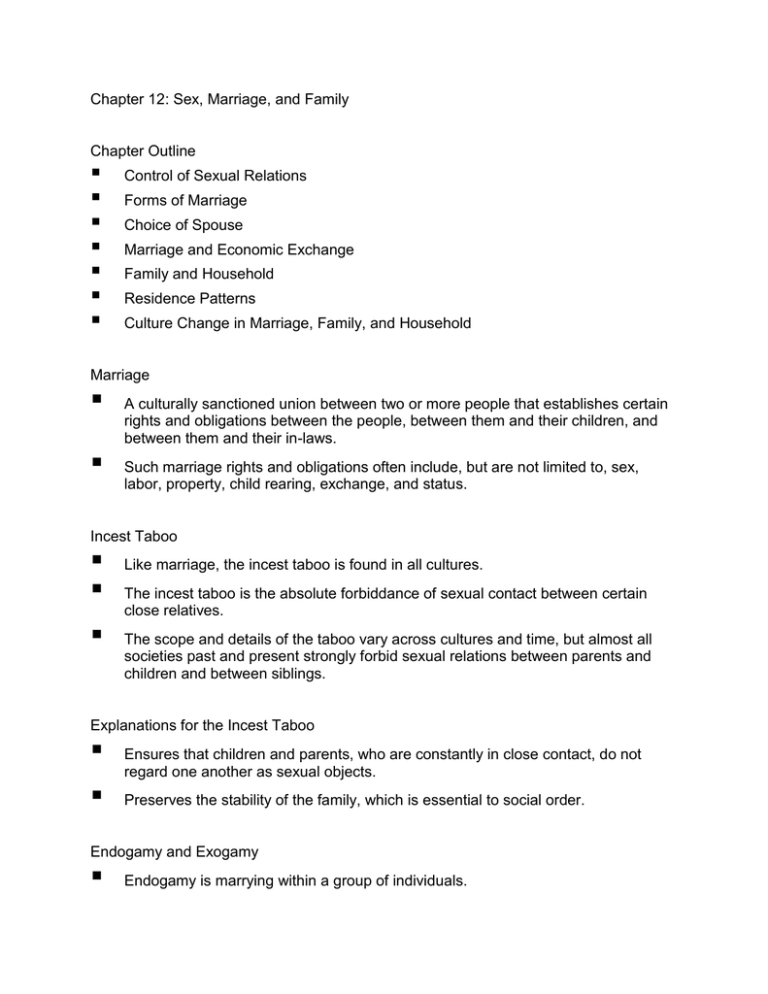
Chapter 12: Sex, Marriage, and Family
Chapter Outline
Control of Sexual Relations
Forms of Marriage
Choice of Spouse
Marriage and Economic Exchange
Family and Household
Residence Patterns
Culture Change in Marriage, Family, and Household
Marriage
A culturally sanctioned union between two or more people that establishes certain
rights and obligations between the people, between them and their children, and
between them and their in-laws.
Such marriage rights and obligations often include, but are not limited to, sex,
labor, property, child rearing, exchange, and status.
Incest Taboo
Like marriage, the incest taboo is found in all cultures.
The incest taboo is the absolute forbiddance of sexual contact between certain
close relatives.
The scope and details of the taboo vary across cultures and time, but almost all
societies past and present strongly forbid sexual relations between parents and
children and between siblings.
Explanations for the Incest Taboo
Ensures that children and parents, who are constantly in close contact, do not
regard one another as sexual objects.
Preserves the stability of the family, which is essential to social order.
Endogamy and Exogamy
Endogamy is marrying within a group of individuals.
Exogamy is marrying outside a group.
If the group is limited to the immediate family, almost all societies can be said to
prohibit endogamy and practice exogamy.
Societies that practice exogamy at one level may practice endogamy at another.
Monogamy
The taking of a single spouse.
This is the most common form of marriage, primarily for economic reasons.
Serial monogamy, in which a man or woman marries a series of partners, has
become common among Europeans and North Americans.
Polygamy
When one individual has multiple spouses.
Two forms:
–
–
polyandry – marriage of a woman to two or more men at the same time
polygyny – marriage of a man to two or more women at the same time
Polyandry in Nepal
Same-Sex Marriage
Same-sex marriages exist in some societies.
Woman–woman marriages are practiced in some African cultures for social and
economic reasons (see pg. 235 of textbook)
In recent years, Belgium, Canada, Spain, and the Netherlands have legalized
same-sex marriage.
Three Common Arguments Against Same Sex Unions
•
•
“Marriage has always been between males and females.”
•
Yet same-sex marriages have been documented in a number of
societies.
“They legitimize gays and lesbians, whose sexual orientations have been widely
regarded as unnatural.”
•
•
Neither cross-cultural studies nor studies of other animal species
suggest that homosexual behavior is unnatural.
“The function of marriage is to produce children.”
•
But marriage involves economic, political, and legal considerations.
Marriage and Economic Exchange
In many human societies, marriages are formalized by an economic exchange.
–
–
–
Bride-price (also called bridewealth) is the payment of money or other
valuables from the groom’s to the bride’s kin.
Bride service occurs when the groom is expected to work for a period for
the bride’s family.
A dowry is the payment of a woman’s inheritance at the time of marriage to
her or her husband.
Family and Household
Dependence on group living for survival is a basic human characteristic, and
gender plays at least some role in the division of labor.
The presence of adults of both sexes in a residential group provides children with
models from whom they can learn the gender-appropriate roles defined in that
society.
Family
A family is defined as two or more people related by blood, marriage, or adoption.
The family may take many forms, ranging from a single parent with one or more
children, to a married couple or polygamous spouses with offspring, to several
generations of parents and their children.
A conjugal family is a family established through marriage.
A consanguineal family is a family of “blood relations”
Household
A family is distinct from a household, which is the basic residential unit where
economic production, consumption, inheritance, child rearing, and shelter are
carried out.
In the vast majority of human societies, most households are made up of families
or parts of families, but there are many other household arrangements.
The Nuclear Family
The smallest domestic unit.
Consists of one or two parents and dependent offspring, which may include a
stepparent, stepsiblings, and adopted children.
The extended family consists of several closely related nuclear families living and
often working together in a single household.
The Extended Family
•
•
•
Two or more closely related nuclear families clustered together into a large
domestic group.
This is traditionally found in horticultural, agricultural, and pastoral societies.
Because members of the younger generation bring their husbands or wives to
live in the family, extended families have continuity through time.
Residence Patterns
Three common residence patterns are:
–
–
–
Patrilocal – in which a married couple lives in the husband’s father’s family.
Matrilocal – in which a married couple lives living in the wife’s mother’s
family.
Neolocal – living in a locality apart from the husband’s or wife’s relations.
Cultural Changes to Marriage, Family, and Households
•
New forms of family are emerging today because of new social arrangements
and new technologies:
•
•
Blended families consist of a married couple raising children from
previous unions.
New reproductive technologies (NRTs), such as in vitro
fertilization and surrogacy, have led to children having relationships
with both biological and adoptive parents.
Older Parents & NRT in Canada
Skewed Sex Ratio in India
Bride Shortages
Solutions:
–
–
–
Involuntary bachelorhood
Fraternal polyandry
Importation of brides from other states or countries






